No-knead focaccia is a super-easy snack idea made with zero effort and no technique (not even kneading). With the softest crumbs, fantastic texture, and delicious flavor, it’s the easy focaccia recipe you didn’t know you were looking for.
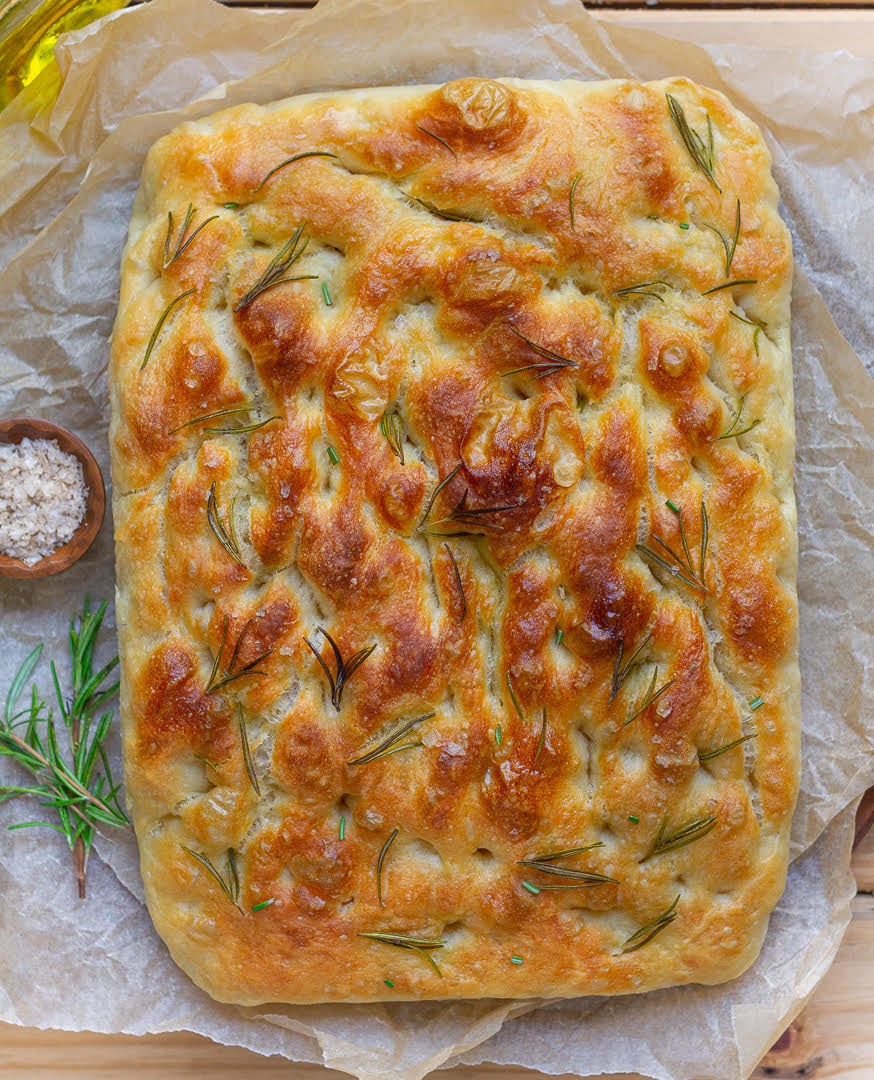
This homemade focaccia gives that visceral satisfaction you can get only from freshly baked bread! Barely out of the oven, and I know it’s the best focaccia bread I’ve made, and that’s saying something because I’ve baked by the dozen.
The warm crust is fragrant with rosemary, and when you bite in, it crunches marvelously, and then you get the kick from the sea salt. The crumbs are soft but still chewy and with that little tang from the long fermentation that makes you have one more slice.
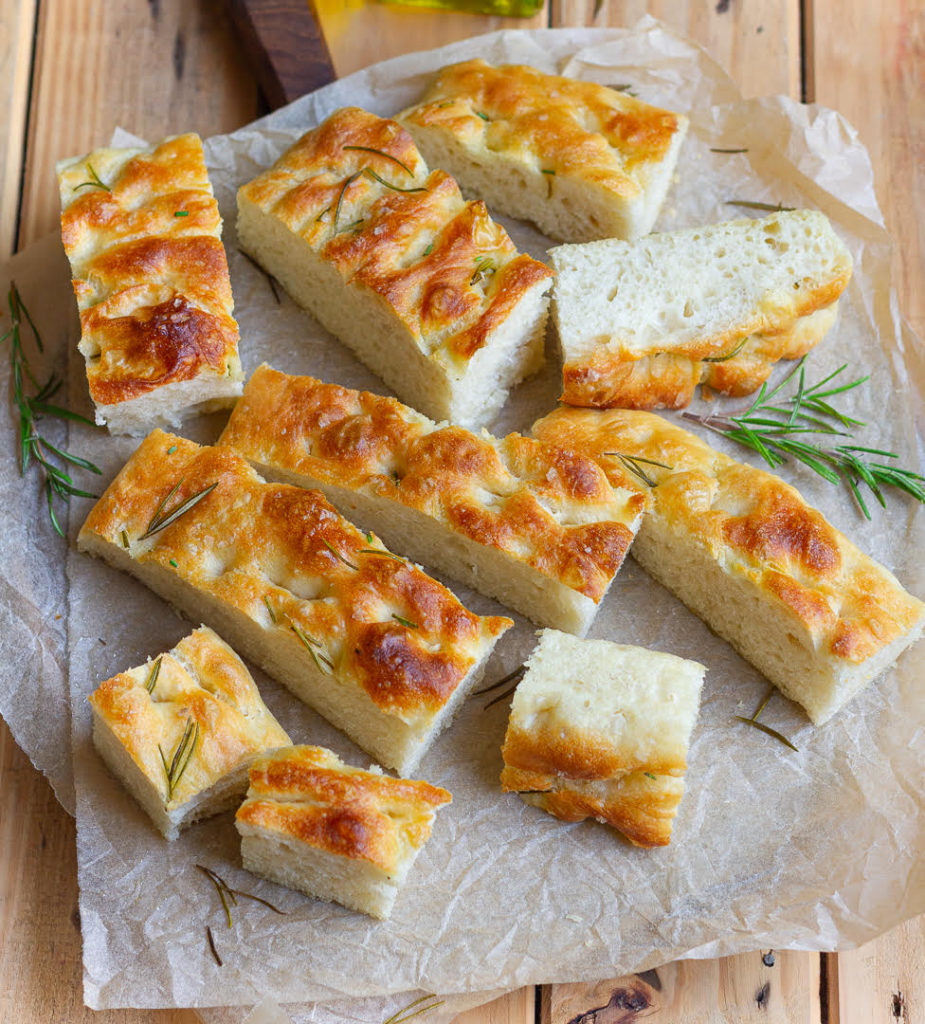
Jump to:
Why should you make this recipe
Why do you need to try this recipe for homemade focaccia?
It requires no kneading. The fridge and oven do most of the work.
It takes zilch effort — only 15 minutes over 2 days!
It uses no special equipment or technique. Just a pan, a whisk, a spatula, and some folding over.
Never baked bread at home? This is the safest, easiest, and tastiest recipe to begin with!
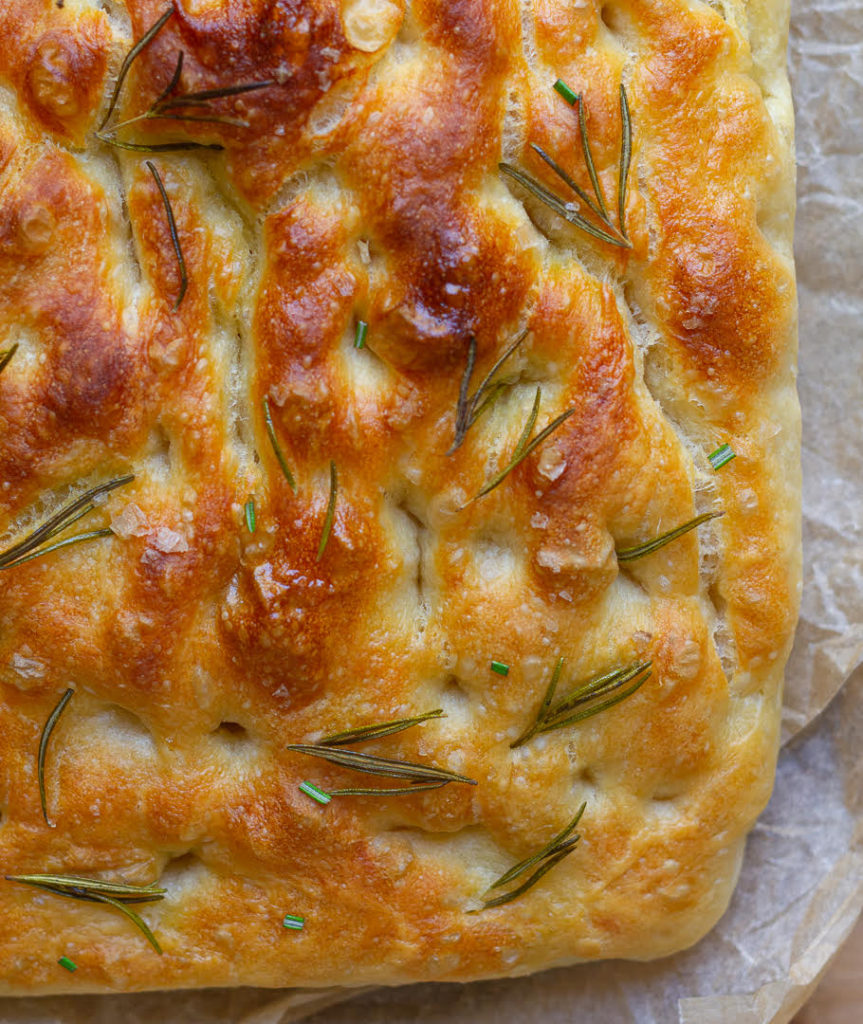
What is the no-knead method?
I love the no-knead method of making bread. Like everyone on this earth, I was introduced to the concept by Jim Lahey long, long ago. My copy of his book became a bible of sorts and Jim, my guru.
Since then, I’ve baked plenty of no-knead breads, but this homemade focaccia (adapted from Alexandra’s Kitchen with a few Tasha twists thrown in) was the simplest. By far.
Why? Because (a) the dough was the most comfortable to work with, (b) it gave excellent results, and (c) it’s fantastic for beginners.
So, what is the super easy no-knead method?
It’s exactly what it says. You mix all the ingredients (flour, salt, sugar, and yeast) in a bowl and let it sit and proof. You don’t knead.
How does it work?
In bread, there are 2 ways to form a gluten network (the internal structure that makes freshly baked bread so amazing).
The first is kneading.
As you work the dough with your hands, the normally knotted up proteins in the flour untangle, and join together, developing the network of gluten.
The other is by letting the dough rest.
When you give the dough a lot of time to proof, the proteins break down into teeny, tiny (and manageable) strands. At the same time, thanks to the yeast consuming sugar, air bubbles (CO2) start to bubble up in the dough.
These bubbles push and nudge the protein strands into alignment. And once they are lined up like good little soldiers, they start to cross-link, creating the network of gluten. Without you having to knead the dough till your forearms hurt.
So much science!!
How to make no knead focaccia?
The key here is time.
Because there is no kneading involved, it needs a long rise. The longer you let the dough rest, the more depth of flavor and airy crumbs you get.
Yes, this means you need to plan ahead, but who's complaining when you literally don’t have to do anything else for this recipe!
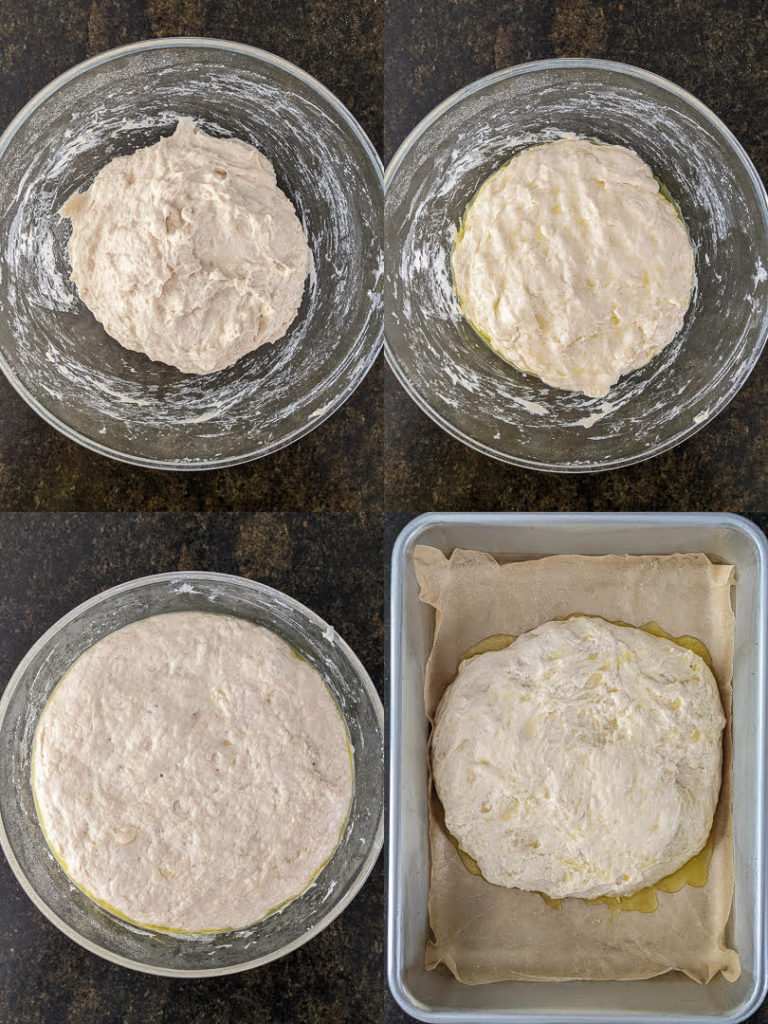
On day 1 do 5 mins of prep on no-knead focaccia
Step 1: Combine the ingredients for focaccia bread (flour, salt, and yeast). Whisk in a teaspoon of sugar.
Step 2: Add water and with a spatula mix until everything is blended, and you have a well-hydrated dough. It’ll be sticky and shaggy.
Step 3: Paint the dough surface with olive oil so that the top layer doesn’t become dry and crusty during the first rise.
Step 4: Cover the bowl with cling wrap or a kitchen towel. For those using a towel, I recommend securing it with a rubber band to keep it draft-free.
Step 5: Slide the bowl into the fridge and let it do its magic for 18 to 24 hours.
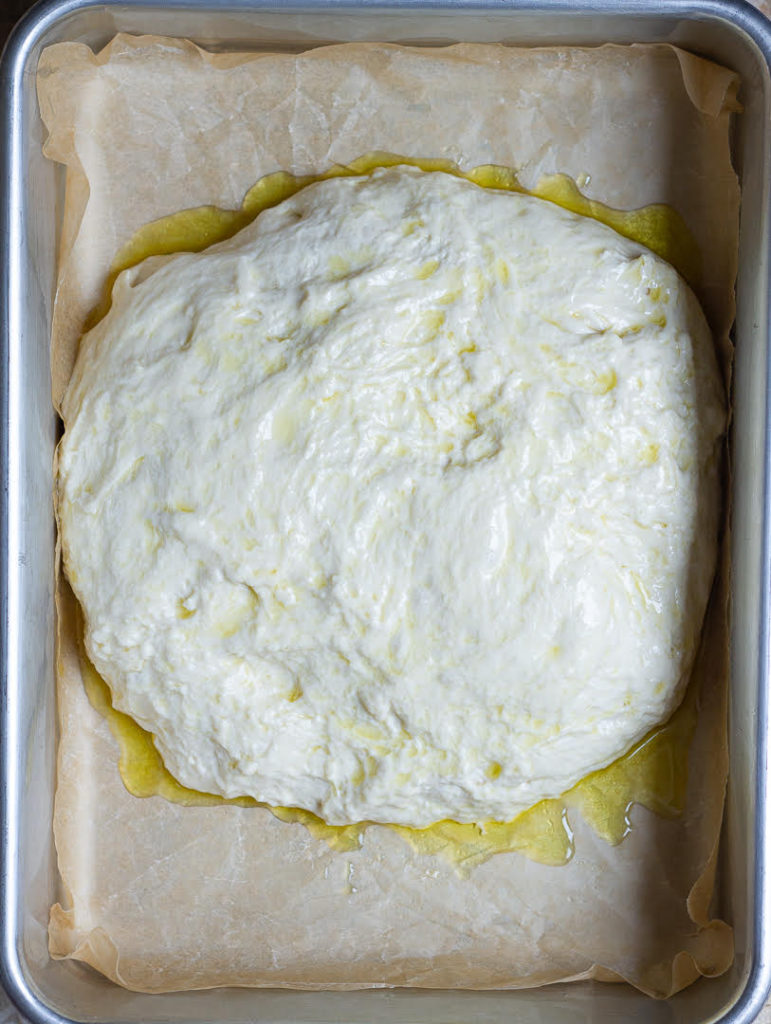
On day 2 bake the no-knead focaccia bread
Step 6: By the next day, the dough would have risen well. You’re now going to deflate it gently. First, oil your hands and then scrape the dough away from the edges.
Step 7: Next, turn the dough over in 4 parts. Hold a portion of dough and fold it towards the center. Rotate the bowl a quarter turn and then fold over the dough again. Rotate the bowl and fold the dough 2 more times. This completes 1 cycle.
Step 8: Do the fold and rotate process one more time to form a rough ball.
Step 9: Now, prep your pan by greasing it well with olive oil. This particular pan of mine tends to be sticky, so I also lined it with parchment paper. After that, I poured some more oil smack-dab in the middle.
Step 10: Lift the dough off the bowl and plonk it over the olive oil in your baking dish.
Step 11: Let the focaccia dough proof a second time. Since it’s warm here, my rise took about an hour and a half.
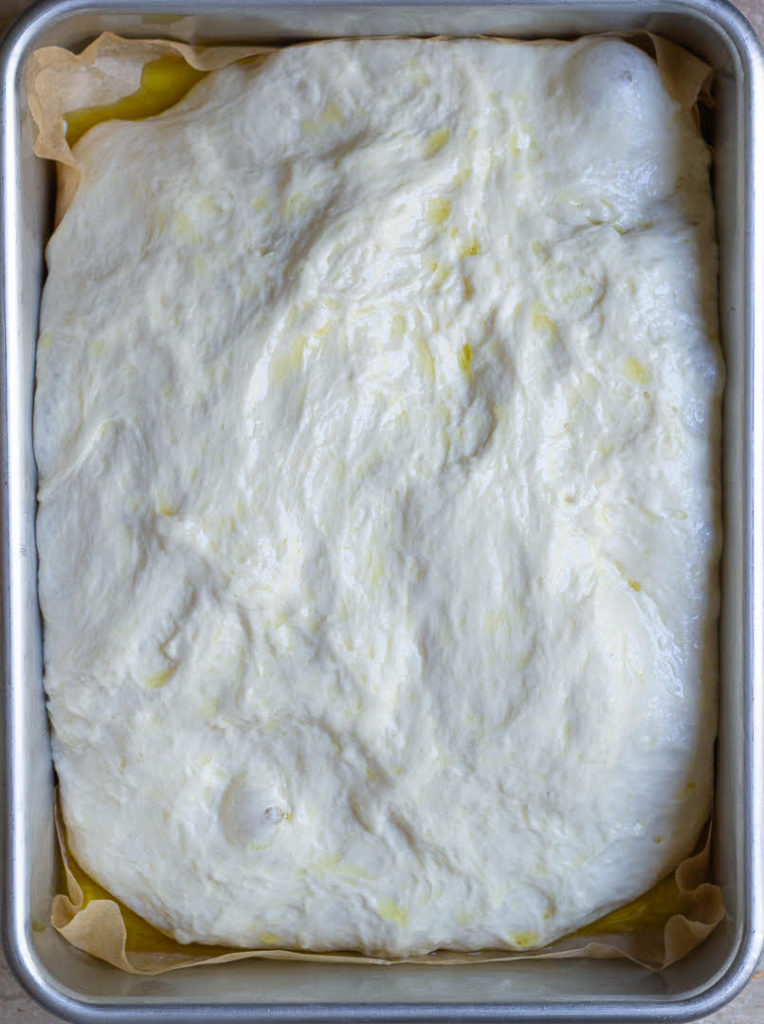
Now, let’s bake the best focaccia bread
Step 12: Homemade focaccia bread needs a hot, hot, hot oven. So, preheat it to 220 °C or 425 °F.
Step 13: While the oven preheats, get to the fun part. Scatter rosemary on the soft dough.
Step 14: Spread more olive oil on top, and then make dimples by shaping your fingers into claws and pressing them into the pillowy dough. The feeling is utterly satisfying, like sinking your hands in cotton.
Step 15: Sprinkle with sea salt immediately and bake for 25 to 30 minutes, until the crust is golden brown.
Final step: Let the no-knead focaccia cool a bit and serve.
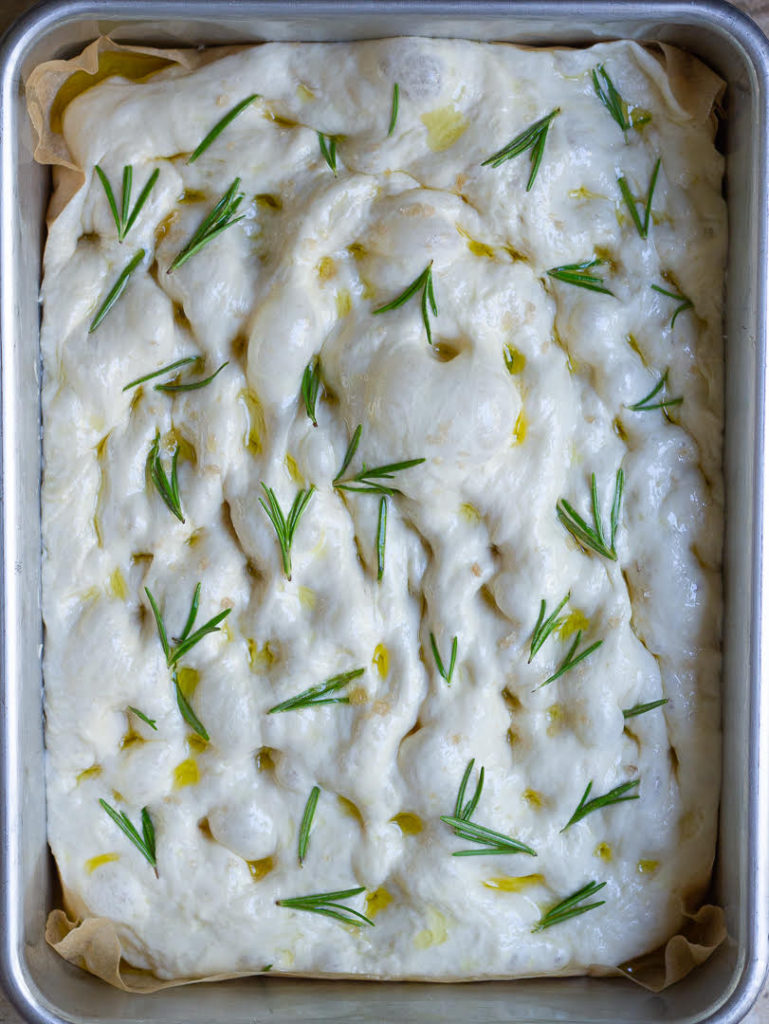
My tips for homemade focaccia bread
- Make sure your dough is not too wet or too hard. The best way to achieve the right consistency is to measure your ingredients.
- I am a big fan of cup measurements as they’re very convenient, but this recipe for homemade focaccia needs accuracy. And, frankly speaking, cups are not precise. So, invest in a kitchen scale. Even a small battery-operated one will make all the difference.
- Use a 9 by 13" or 10 by 12" baking dish. If you don’t have either, opt for a 10" round pan. Or you can split the dough into two 9-inch pans.
- Always add all your focaccia toppings before the olive oil. The slick coating keeps them from getting burnt during baking.
- The only thing I’d do differently the next time I bake no-knead focaccia is to use more rosemary. At least half the amount more, if not double.
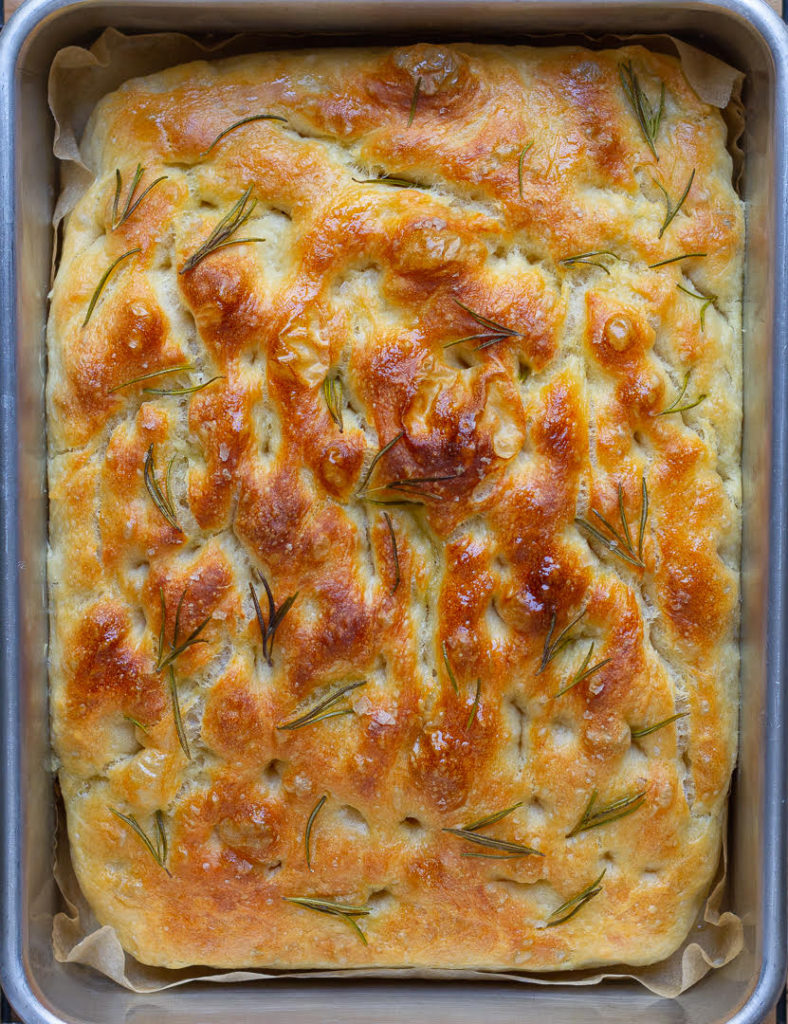
How do you know the dough is ready after the 2nd proof?
It’ll spread out to fill the pan and will be dotted with beautiful bubbles.
Why do you need to add olive oil to the baking dish?
Greasing the baking dish is the best way to ensure the cake, the bread, the brownie, or whatever else you’re baking doesn’t stick to it. With no-knead focaccia, we go a step further.
We’re not just coating the pan but also pouring the olive oil right in the center. It’s a hefty amount that allows the bottom of the bread to bake gorgeously, lending it that crunchy, chewy texture and complex flavor.
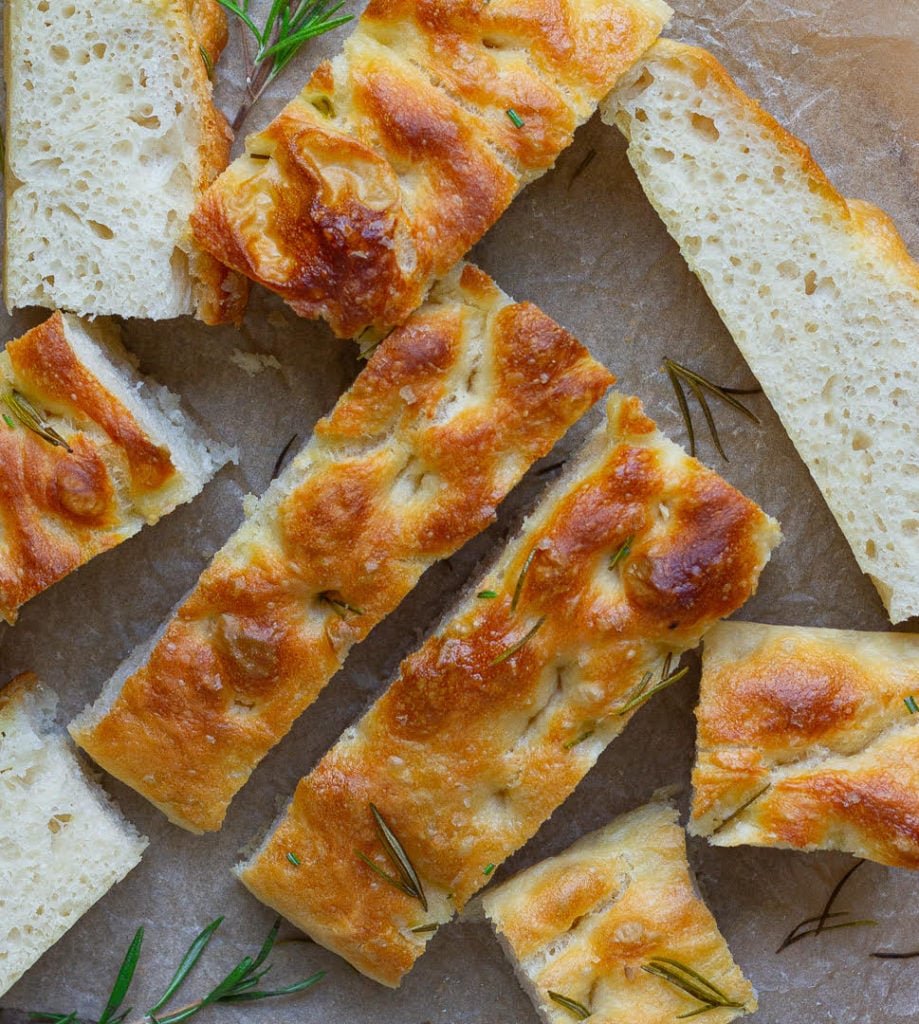
Focaccia variations you can try
Herbs: Rosemary is the classic choice for focaccia, but don’t let that stop you from experimenting. Any herb you prefer will be fantastic. Thyme, for example.
You can even mix it in the dough, as I did with my herb and garlic focaccia. Incidentally, if you’re looking for quicker homemade focaccia bread, that’s the recipe you should try.
Toppings: From olives to cherry tomatoes, from sliced onions to figs, you can bake endless focaccia versions. Or go to town with toppings and create an entire Instagrammable gardenscape.
Serving the no-knead focaccia
Serve it warm, and the tender interior and crisp crust simply beg for a nibble.
Let it cool and serve it in slices as an easy snack or even an appetizer. And if there’s any leftover, although I hardly think so, use it for sandwiches.
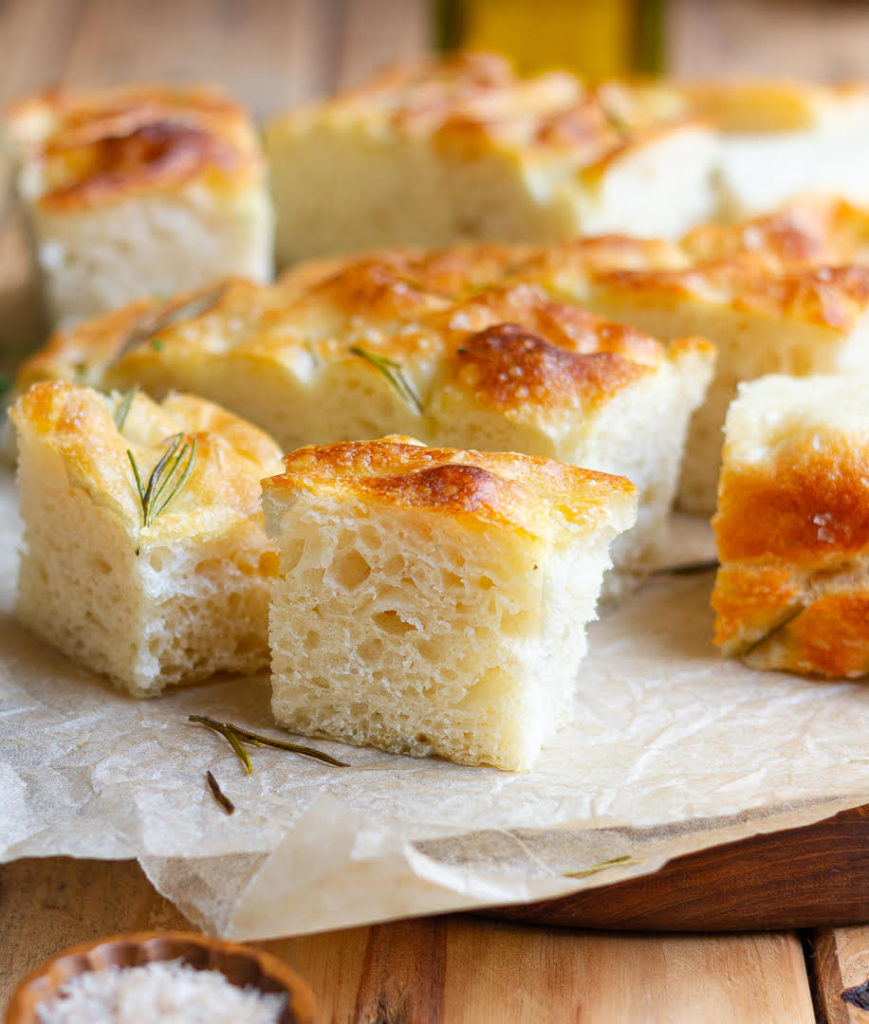
📖 Recipe
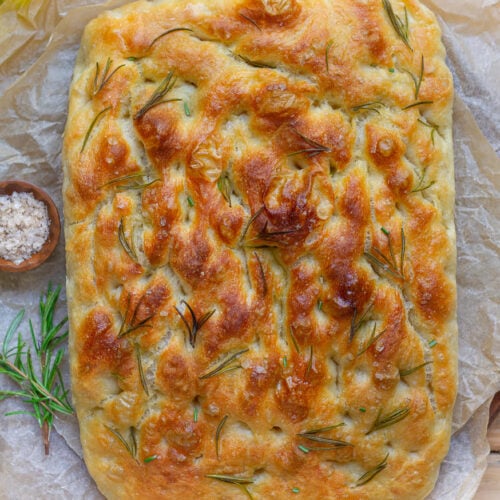
Super Easy No-Knead Focaccia
Ingredients
- 4 cups All-purpose flour
- 2 tsp Yeast
- 1 tsp Salt
- 2 tsp Sugar
- 2 cups Lukewarm water
- 4 tbsp Olive oil
- Sea salt and Rosemary for sprinkling on top
Instructions
- Combine the flour, yeast, salt, and sugar in a large bowl.
- Pour over the lukewarm water. Mix well with a spatula until a sticky dough is formed.
- Pour a teaspoon or two of olive oil on the surface of the dough and rub it all over.
- Cover with plastic wrap and refrigerate for 18-24 hours. I kept it for 24 hours.
- When you're ready to bake, grease a 9" x 13" or 10" x 12" pan. Line the bottom with parchment paper. You may not need to do that if your pan is non-stick.I used a 10" x12" pan and lined it too.
- Take out the refrigerated dough. Oil your hands and gently bring the proofed dough in from the sides of the bowl.
- Fold the dough over itself. Turn the bowl a quarter of the way and fold the dough over itself again. Do 3 more quarter turns of the bowl with folding over the dough each time.Repeat this step once more.
- Pour 2 tablespoons of olive oil in the center of the prepared pan.
- Gently place the deflated dough on the olive oil. Roll it a couple of times to coat it well with oil.
- Cover this with plastic wrap or a kitchen towel and keep in a draft-free place for 2-4 hours or until the dough doubles and covers the pan.Mine doubled in 1.5 hours.
- Preheat the oven to 220 C.
- Sprinkle rosemary ( if using ) all over the surface of the dough.
- Pour over the remaining 2 tablespoons of olive oil on the dough and spread it all over. Dimple the dough using your fingers. Sprinkle the sea salt.
- Bake the bread at 220 C for 25-30 minutes, until the top is golden brown. The bottom of the bread should be crispy.
- Let the bread rest in the pan for 5 minutes before turning it out on a cooling rack. Slice warm or let it cool completely. Enjoy!
Nutrition
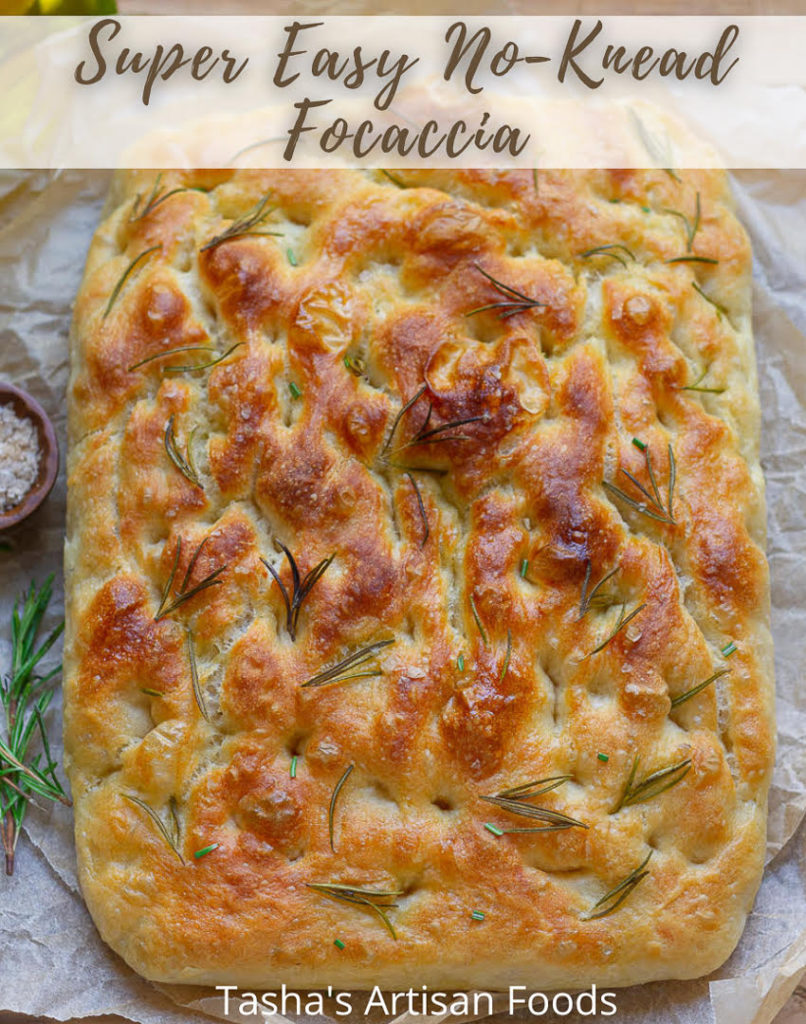




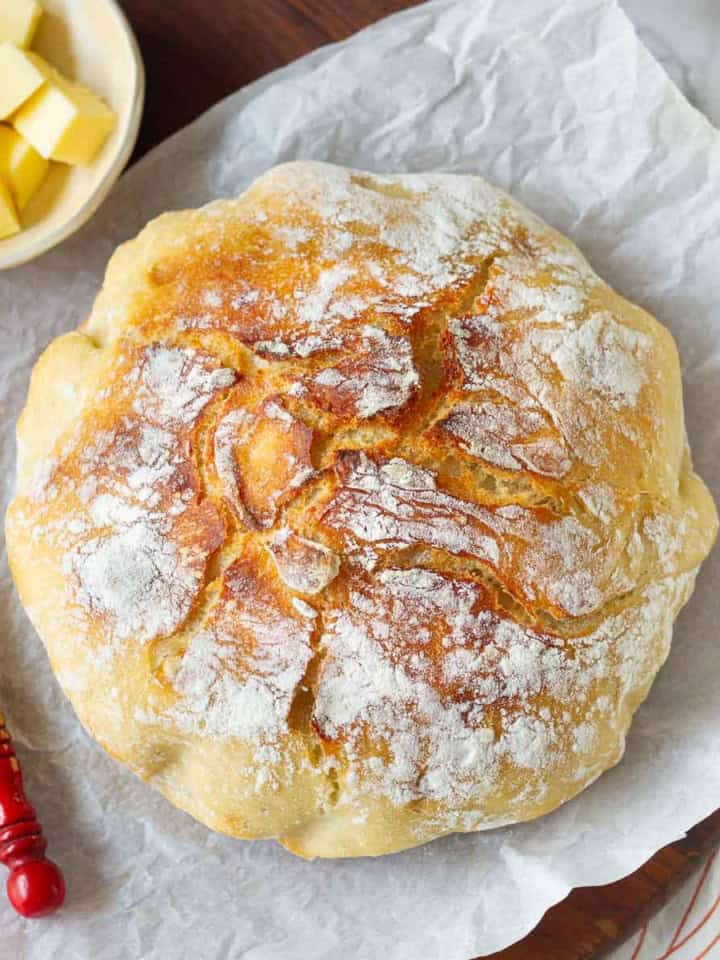
Mai Walsh says
Excellent recipe which I followed completely except for rosemary...just used sea salt. Taste absolutely fabulous
jackie says
Hi! i absolutely love this recipe & have made it a bunch of times. I am going to make it for xmas again. how many days do you think i can make the bread in advance (without freezing) & for it to remain fresh?
thanks in advance!
jackie
Natasha Minocha says
Hi Jackie, so glad you enjoy this recipe! I make it very often too. I think a day in advance would be fine. Wish you Happy Holidays and happy baking! xx
Rama says
Hi, I'm trying making focaccia for the first time! Just wanted to check - I'm using Allison's strong white bread flour, do you think I'll end up with something else that I'm expecting, since you've made it with APF?
Natasha Minocha says
Hi Rama, I think this flour should work very well for this recipe. Bread flour has more protein which translates to better gluten development.Hope this helps. Happy baking! xx
Baylei says
This bread turned out absolutely amazing!
I will admit, I’m a rosemary hater, so I topped it with oregano, but oh my gosh it tastes too good!
Natasha Minocha says
Thank you so much Baylei!So appreciate your feedback and support! xx
Ally says
Hi,
Can I use coconut flour for this recipe??
Natasha Minocha says
Hi Ally, I'm really not sure as I haven't this recipe with any gluten-free flour. But if you do try it, please do let me know how it worked out for you. 🙂
Kate says
What is the flour measurement y weight. You suggested it is better to weigh rather than using the cup method.
Natasha Minocha says
Hi Kate, the metric measurements are also mentioned in the recipe card. Please click on the metric tab right by the side of US Customary. I prefer to weigh my ingredients, but give both measurements, cup and metric as a lot of my readers use cup. Happy baking 🙂
Debbie Tracey says
Hi there,
1st time making this recipe, delicious...I was nervous how it would turn out, cause I used quick rise instant yeast....well the result was great.
Crunchy outside and bubbly inside...will certainly be making this all year.
Thanks Tasha
Natasha Minocha says
Oh I'm so thrilled to hear that Debbie! Thank you so much for trying the recipe and sharing your baking story with me. It means a lot to me. Love that this recipe is a keeper for you! I love it too and make this bread so often.
Have a great weekend and happy baking! xoxo
Debbie Tracey says
Hi there,
Just took mine out of the oven....very interesting shapes..lol
I used quick rise instant yeast...would that be the cause...super high in the middle then thinner towards the edges???
Will leave another comment once I cut and taste...
Debbie T
Natasha Minocha says
Lol! You can try to even the dough out a bit using your fingers. Rub a bit of olive oil on your hands when you that, the dough won't stick as much then:)
John says
How long does it stay good and do you need to refrigerate it after one day?
Natasha Minocha says
Hi John, homemade focaccia is best eaten the day it's made. That said, it does stay well refrigerated for 2-3 days.Hope this helps:)
Jessie says
Hi Natasha, I wonder what is the temperature in fahrenheit, I live in the states. Thank you
Natasha Minocha says
Hi Jessie, 220 C is 428 or 430 Fahrenheit. Happy baking! xx
Christine says
This makes a very large loaffor just my husband and me. Before I do the second rise, can I cut it in half and freeze part to rise and make later?
Natasha Minocha says
Hi Christine, I suppose you can do that. I haven't tried that tough. But I do have a mini no-knead focaccia recipe on the blog too. Maybe you can try that? Its perfect for 1-2 people.
Thank you for following along! xx
Mirela Mastrelli says
I am making your focaccia bread recipe for the 4th time. It’s really amazing and easy and comes out perfect every time. The bubbles are so fun to press on and stretch with my fingers. I’ve been using a smaller pan so it comes out tall and fluffy. We all love it. Just can’t believe how easy it is. The no kneading is new to me and I love it. It’s so easy. I mix it and put it in the fridge overnight and bake it the next day. Wow!!
Thank you for the recipe.
Natasha Minocha says
How absolutely wonderful!! Thank you for your amazing feedback Mirela. You made my day! xx
Elisa says
I halved the ingredients as we didn't have a form large enough. It worked out perfectly! Wow and it is the first time I make this type of bread.
I usually always worry a lot about whether I did the steps correctly and whether that is truly the desired texture etc. Even though I halved the ingredients and certainly am not used to measuring water in grams or cups for that matter I felt very confident after mixing everything together thanks to your descriptions.
I feel like this is truly a fool proof recipe thank you so much!
Natasha Minocha says
Wow,that sounds amazing, Elisa! Thank you very much for trying this recipe ( and making it your own) and for sharing your fabulous feedback. You made my day! Happy baking xoxo
Sherry says
My husband loves this recipe better than any other bread I’ve baked. Another round in the fridge today. Rosemary and oregano are ready in the garden so I’m super excited to make this with fresh herbs.
It’s easy and so good. Thank you.
Natasha Minocha says
Awwww! That's so wonderful to know! Thank you for trying this recipe and for your lovely message, Sherry. xx
Queene says
While experimenting with several Focaccia recipes, I found your recipe resulted in a quite dense texture. Focaccia should be light and airy with plenty of bubbles resulting in a light, crisp texture when baked.
Natasha Minocha says
Yes, you are right. Focaccia should be light and airy and I'm sorry this recipe didn't work out well for you. But thank you for trying and for your honest feedback. 🙏🏻
Maria says
Hi Natasha
I’ve made this several times without the sugar using 2 9” round pans, parchment paper and 2 tablespoons of olive oil in each pan….perfection. . Last time I made it I added sugar, again using 2 tablespoons of oil in each pan with no parchment paper. They were delicious except they were VERY greasy. I always use a measuring spoon. Can I cut the last step to 1 tbsp per 9” pan? Will this help or did I do something wrong? Anything you can share will be fabulous. Thanks!
Natasha Minocha says
Hi Maria, so glad you enjoy this bread! So I don't quite know where you might have gone wrong. Adding sugar shouldn't make it greasy. Maybe just continue with the parchment paper and 2 tbsp of olive oil at the bottom. The oil is there to help the base of the bread get crispy and the sugar just for balance of flavors and to help feed the yeast. But if your bread is turning out delicious without the sugar, then please continue as you have been. Hope this helps. 🙂
Thank you for your support, I really appreciate it. xoxo
Suze says
Obsessed with this recipe, I make it every week!
Natasha Minocha says
Wow! Thank you so much Suze! Really appreciate your support. xoxo
VICKI says
This turned out really well. It IS easy, raised beautifully and baked to a gorgeous golden brown. My personal preference is for a little more salted bread so I'll add more the next time I make it but this is more of the Tuscan style which is unsalted.
Natasha Minocha says
Thank you so much, Vicki! I'm thrilled to hear this! Also, thank you for sharing the interesting fact about this focaccia. I had no clue! xoxo
Wendy Savoie says
This was my first attempt at trying this type of bread. I actually made it for my friend as she loves focaccia bread and figured she would be a good judge in flavor and consistency. She absolutely loved it. So, I made another batch last night for my family and just took it out of the oven a few minutes ago. The house smells amazing and I cannot wait to try it. Thanks for the recipe, it will definitely be on repeat 🙂
Natasha Minocha says
Yayyyyy! I'm thrilled to hear this, Wendy! Thank you so much, its so appreciated. xoxo
apkmodguru says
The content of your recipe is very simple, thanks for that.
Natasha Minocha says
Thank you very much. 🙏🏻
Christy says
Oven temperature 220 Celsius is what in Fahrenheit?
Natasha Minocha says
Hi Christy, 220 Celcius is 428 Fahrenheit. Hope this helps.:)
apkmodguru says
It is very easy to make this recipe, thank you for this.
Natasha Minocha says
I'm so happy to hear this. Thank you so much! xx
Meredith Solfa says
Hi there is I used active yeast would that change the rise time?
Natasha Minocha says
Hi Meredith, I don't anything would really change. This recipe anyways requires slow, overnight rise. So you should be fine using active yeast as well. Happy Baking! 🙂
Margie says
Made this for a party and it was devoured. Used rosemary on top but wondering if incorporating herbs in the dough itself would punch up the flavor?
Natasha Minocha says
Super! Yes, incorporating herbs in the dough would be amazing! Happy baking and Happy Holidays! xx
Nickie says
Can you use bread flour
Natasha Minocha says
Yes sure!
Deanna says
I'm new to bread making, but this recipe was very easy to follow and the bread turned out delicious!
Natasha Minocha says
So glad this worked out well for you, Deanna! Thank you very much for your lovely message. I appreciate you. xx
Carolyn says
If you add tomatoes and garlic do you need to refrigerate after baking ?
Natasha Minocha says
Yes, I would definitely refrigerate the leftover bread. I refrigerate it even without these toppings. Hope this helps. 🙂
David says
This really was incredibly easy and absolutely delicious. I was a tad skeptical of the method, but it turned out beautifully!
Natasha Minocha says
Thank you very much for your wonderful feedback! I'm thrilled the bread turned out well for you!🙏🏻
Swish says
Please mention oven temperature
Natasha Minocha says
Hi, the temperature is mentioned - 220 Celcius. 🙂
Jessie says
Hi Natasha, I wonder what is the temperature in fahrenheit, I live in the states. Thank you
Carol White says
Can I use a glass 9x13 casserole for baking the bread?
Natasha Minocha says
Yes, absolutely. Personally I prefer metal pans, but this can work. Happy baking. 🙂
Tammie Freeman says
I’m really not a baker but I’m an artist so I’m attempting to make this for an awesome appetizer for Easter dinner with friends tomorrow. If it turns out good I’ll post a picture.
Thanks, Tammart07
Natasha Minocha says
Oh, that's amazing Tammie! I hope the bread turned out well. 🙂
Fran says
Do I have to refrigerate the dough or can I let rise then put it in the pan and let it rise again before I bake.
Natasha Minocha says
Hello Fran, So the first rise for the dough is in the refrigerator, for 18-24 hours. The 2nd rise is on the countertop, in the baking pan before you bake it. Hope this helps. 🙂
Lynette Edwards says
What kind of yeast do you use?
Natasha Minocha says
Hi, I use active dry yeast or sometimes instant dry yeast too.
Colleen says
Hi Natasha, will give your focaccia a try, it looks yummy 🙂 Can you please let me know what type of yeast you used in this recipe (ie instant, quick rise or ?) Thanks!
Natasha Minocha says
Hello Colleen, I used instant dry yeast in this recipe. I have made it with active dry yeast too and got good results. Thank you for following along and happy baking! xx
Janet says
I am going to try make this bread. Thank you sharing this recipe.
Natasha Minocha says
Thank you so much! Hope you enjoy it as much as we do. Happy baking! xx
Pratibha says
Your recipes are really amazing. Have been trying them since lockdown days and every one I tried turned out perfect ! And even when I am not able try them , I love to read the mouthwatering write ups ! Kudos
Natasha Minocha says
I am so so happy to read your beautiful comment, Pratibha. Its really very lovely of you to take the time out and write a note here. I appreciate you and am so thankful for your love and support. Have a wonderful day! xoxo
Cara says
This was so easy to make, thanks for the recipe ❤️
Natasha Minocha says
Thank you so much, Cara! xx
EASYFOODSMITH says
My daughter loves all kinds of breads and I am sure she will enjoy this one too. Got to make this for her sometime soon. Thanks for sharing 🙂
Natasha Minocha says
I have big bread lovers in my family too. This one is a boon as its so easy and effortless to make! I hope she enjoys it as much as mine does 🙂